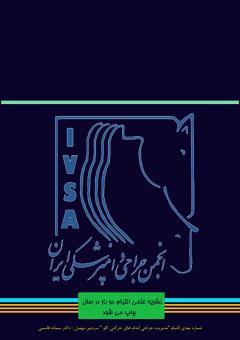Management of birth canal injuries in dairy cows
Subject Areas : Veterinary Soft and Hard Tissue Surgery
Bahare Hafezi
1
,
mohammad ali sadeghi
2
![]() ,
Ahmadreza Mohammadnia
3
,
Ahmadreza Mohammadnia
3
1 - :DVSc candidate, Faculty of Veterinary Medicine, Ferdowsi University of Mashhad, Iran
2 - DVSc candidate, Faculty of Veterinary Medicine, Ferdowsi University of Mashhad, Iran
3 - Associate Professor, Department of Clinical Sciences, Faculty of Veterinary Medicine, Ferdowsi University of Mashhad
Keywords: perineal lacerations, dairy cows, birth canal,
Abstract :
Injuries of the birth canal in cows (perineal lacerations, fistula…) cause significant economic loss in dairy herds. These injuries usually are associated with obstetric trauma during labor. Third degree perineal lacerations and fistula formation usually happen because of dystocia, improper repairs, abscesses and forced extractions and lead to fecal contamination of the birth canal and reduced fertility. The main reason for the birth canal and external part of the reproductive tract surgery is to restore fertility of the animal and repair the injuries associated with dystocia. In this review the causes, management, and treatment of these disorders by emphasizing on the importance of birth canal injuries in cows were discussed.
1. Anderson, David E, and Misty A Edmondson. Prevention and Management of Surgical Pain in Cattle. Veterinary Clinics: Food Animal Practice. 2013; 29 (1): 157-84.
2. Armengol R, Fraile L. Descriptive study for culling and mortality in five high-producing Spanish dairy cattle farms (2006–2016). Acta Veterinaria Scandinavica. 2018; 60(1):1-11.
3. Astiz S, Gonzalez-Bulnes A, Elvira-Partida L, Perez-Villalobos N, Cerviño-Lopez M, Gonzalez-Martin JV. Bovine neonatology. Encyclopedia of life support systems Animal and plant productivity Oxford, United Kingdom: UNESCO: EOLSS. https://www.eolss.net/sample-chapters/C10/E5-15A-33.pdf Available: Jun 17, 2018.
4. Atkinson O, Jean GS, Steiner A, Weaver AD. Bovine surgery and lameness: John Wiley & Sons; 2018: 206.
5. Dogan S, Demirer S, Kepenekci I, Erkek B, Kiziltay A, Hasirci N, et al. Epidermal growth factor‐containing wound closure enhances wound healing in non‐diabetic and diabetic rats. International wound journal. 2009;6(2):107-15.
6. Edmondson MA. Local, regional, and spinal anesthesia in ruminants. Veterinary Clinics: Food Animal Practice. 2016;32(3):535-52.
7. Farhoodi M, Nowrouzian I, Hovareshti P, Bolourchi M, Nadalian MG. Factors associated with rectovaginal injuries in Holstein dairy cows in a herd in Tehran, Iran. Preventive veterinary medicine. 2000;46(2):143-8.
8. Fubini SL, Ducharme N. Farm animal surgery-e-book: Elsevier health sciences; 2016: 478-482.
9. George Broughton I, Janis JE, Attinger CE. The basic science of wound healing. Plastic and reconstructive surgery. 2006;117(7S):12S-34S.
10. Hopper RM. Bovine reproduction: John Wiley & Sons; 2021: 131-135.
11. Hudson RS. Repair of perineal lacerations in the cow. The Bovine Practitioner. 1972; 34-40.
12. Meyer H, Starke A, Kehler W, Rehage J. High caudal epidural anaesthesia with local anaesthetics or α2‐agonists in calves. Journal of Veterinary Medicine Series A. 2007;54(7):384-9.
13. Noakes DE, Parkinson TJ, England GC. Arthur's Veterinary Reproduction and Obstetrics-E-Book: Elsevier Health Sciences; 2018: 203-359.
14. Orsini JA, Grenager NS, de Lahunta A. Comparative veterinary anatomy: a clinical approach: Academic Press; 2021: 989-1249.
15. Peterson AS, Aument W. The “golden period” for wound repair. J Lanc Gen Hosp. 2010;5(4):134-5.
16. Prado TM, Schumacher J, Dawson LJ. Surgical procedures of the genital organs of cows. Veterinary Clinics: Food Animal Practice. 2016;32(3):727-52.
17. Rizk A, Mosbah E. Occurrence and surgical reconstruction of perineal lacerations and rectovaginal fistulae in dairy cows. Journal of Advanced Veterinary Research. 2016;6(4):123-9.
18. Schatten H, Constantinescu GM. Comparative reproductive biology: John Wiley & Sons; 2008: 61-116.
19. Skarda RT. Techniques of local analgesia in ruminants and swine. Veterinary Clinics of North America: Food Animal Practice. 1986;2(3):621-63.
20. Tenhagen BA, Helmbold A, Heuwieser W. Effect of various degrees of dystocia in dairy cattle on calf viability, milk production, fertility and culling. Journal of Veterinary Medicine Series A. 2007;54(2):98-102.


